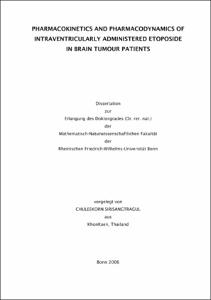Pharmacokinetics and pharmacodynamics of intraventricularly administered etoposide in brain tumour patients

Pharmacokinetics and pharmacodynamics of intraventricularly administered etoposide in brain tumour patients

| dc.contributor.advisor | Jaehde, Ulrich | |
| dc.contributor.author | Sirisangtragul, Chuleekorn | |
| dc.date.accessioned | 2020-04-10T14:21:36Z | |
| dc.date.available | 2020-04-10T14:21:36Z | |
| dc.date.issued | 2007 | |
| dc.identifier.uri | https://hdl.handle.net/20.500.11811/3072 | |
| dc.description.abstract | In order to find the optimal dosage regimen of intraventricularly (ivc) administered etoposide, pharmacokinetic disposition of etoposide in cerebrospinal fluid was investigated in 22 patients (119 cycles) after intraventricular administration of three different dosage regimens (0.25 mg/12 h, 0.5 mg/24 h and 1.0 mg/24 h) through an Ommaya reservoir. Moreover, the effect of two dosage regimens on etoposide antiproliferative activity was studied in vitro using medulloblastoma cells. CSF concentrations of etoposide were determined by reversed-phase high-performance liquid chromatography (HPLC) with electrochemical detection. The pharmacokinetic parameters were estimated by using a two-compartment model and Bayesian curve fitting. The effect of drug concentration and exposure (AUC) on etoposide antiproliferative activity was evaluated by using the colony forming assay. Two different dosing schedules (once daily and twice daily each for 5 days) were simulated by using the in vitro dilution model. The pharmacokinetics of etoposide in the CSF was found to be dose- and schedule-independent in the dose range studied as no statistically significant differences were found in terminal half-life (t1/2Z), volume of distribution (Vss) and clearance (CL) among the three dosage regimens. The in vitro pharmacodynamic investigation revealed that the twice daily regimen is associated with a higher antiproliferative activity than the once daily regimen. The clinical results indicate linear pharmacokinetics of intraventricularly administered etoposide in the CSF which is an important prerequisite for the safe use of this new mode of administration. The in vitro results suggest that a more frequent administration of etoposide is favourable as the antiproliferative activity is higher with the same total drug exposure. | en |
| dc.language.iso | eng | |
| dc.rights | In Copyright | |
| dc.rights.uri | http://rightsstatements.org/vocab/InC/1.0/ | |
| dc.subject | Pharmazeutische Chemie | |
| dc.subject | Etoposid | |
| dc.subject | intraventrikulär | |
| dc.subject | Pharmakokinetik | |
| dc.subject | Pharmakodynamik | |
| dc.subject | Hirntumoren | |
| dc.subject | Etoposide | |
| dc.subject | intraventricular | |
| dc.subject | pharmacokinetic | |
| dc.subject | pharmacodynamic | |
| dc.subject | brain tumour | |
| dc.subject.ddc | 540 Chemie | |
| dc.subject.ddc | 590 Tiere (Zoologie) | |
| dc.subject.ddc | 610 Medizin, Gesundheit | |
| dc.title | Pharmacokinetics and pharmacodynamics of intraventricularly administered etoposide in brain tumour patients | |
| dc.type | Dissertation oder Habilitation | |
| dc.publisher.name | Universitäts- und Landesbibliothek Bonn | |
| dc.publisher.location | Bonn | |
| dc.rights.accessRights | openAccess | |
| dc.identifier.urn | https://nbn-resolving.org/urn:nbn:de:hbz:5N-09958 | |
| ulbbn.pubtype | Erstveröffentlichung | |
| ulbbnediss.affiliation.name | Rheinische Friedrich-Wilhelms-Universität Bonn | |
| ulbbnediss.affiliation.location | Bonn | |
| ulbbnediss.thesis.level | Dissertation | |
| ulbbnediss.dissID | 995 | |
| ulbbnediss.date.accepted | 13.02.2007 | |
| ulbbnediss.fakultaet | Mathematisch-Naturwissenschaftliche Fakultät | |
| dc.contributor.coReferee | Süverkrüp, Richard |
Dateien zu dieser Ressource
Das Dokument erscheint in:
-
E-Dissertationen (4465)




